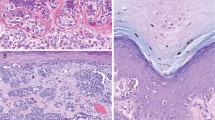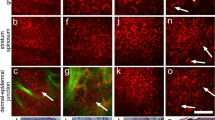Abstract
The dysplastic melanocytic nevus (DMN) is the key clinical marker for the familial dysplastic nevus syndrome and has also been associated with high risk for non-familial melanoma. Characterisations of DMN itself have been qualitative and on a case-by-case basis. In this study, we provided clinical and histological characterisations for each of 150 pigmented lesions from 150 patients with prior malignant melanoma. The steps involved in the study were as follows: (1) The two to four clinicians characterised pigmented lesions on each of 150 patients, and the lesion closest in characteristics to an atypical nevus was quantitatively described based on size, border characteristics and colour characteristics; (2) The lesion was then removed and independently quantified by a single dermatopathologist without knowledge of the clinical features; (3) We computed the correlation between each of the clinical variables and each of the histologic features for each of the 150 patients. Histologic diagnosis of dysplastic nevus was strongly associated with total number of palpable arm nevi, total number of any arm nevi, total number of nevi on the body of any type, and total number of clinically atypical nevi on the body (correlation coefficients 23.2% to 30.4% with P less than 0.01 in each instance). There were also strong correlations between the counts of numbers of nevi and certain types of architectural histologic features, including fusion (bridging of junctional nests), lymphocyte response and fibroplasia of the papillary dermis. Histologic evaluation of solar elastosis was negatively correlated with total numbers of nevi and total number of clinically atypical nevi (P less than 0.01). Freckling on forearm and on shoulders showed no significant positive or negative correlations with any of the histologic features nor with overall diagnosis of dysplastic nevus. We conclude that observations regarding total numbers of nevi (either normal or clinically atypical nevi) are correlated with nuclear and architectural histologic dysplasia on biopsy of the most atypical pigmented lesions.
This is a preview of subscription content, access via your institution
Access options
Subscribe to this journal
Receive 24 print issues and online access
$259.00 per year
only $10.79 per issue
Buy this article
- Purchase on Springer Link
- Instant access to full article PDF
Prices may be subject to local taxes which are calculated during checkout
Similar content being viewed by others
Author information
Authors and Affiliations
Rights and permissions
About this article
Cite this article
Roush, G., Barnhill, R. Correlation of clinical pigmentary characteristics with histopathologically-confirmed dysplastic nevi in nonfamilial melanoma patients. Studies of melanocytic nevi IX. Br J Cancer 64, 943–947 (1991). https://doi.org/10.1038/bjc.1991.431
Issue Date:
DOI: https://doi.org/10.1038/bjc.1991.431



